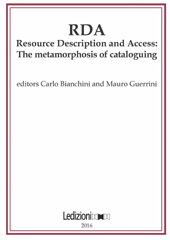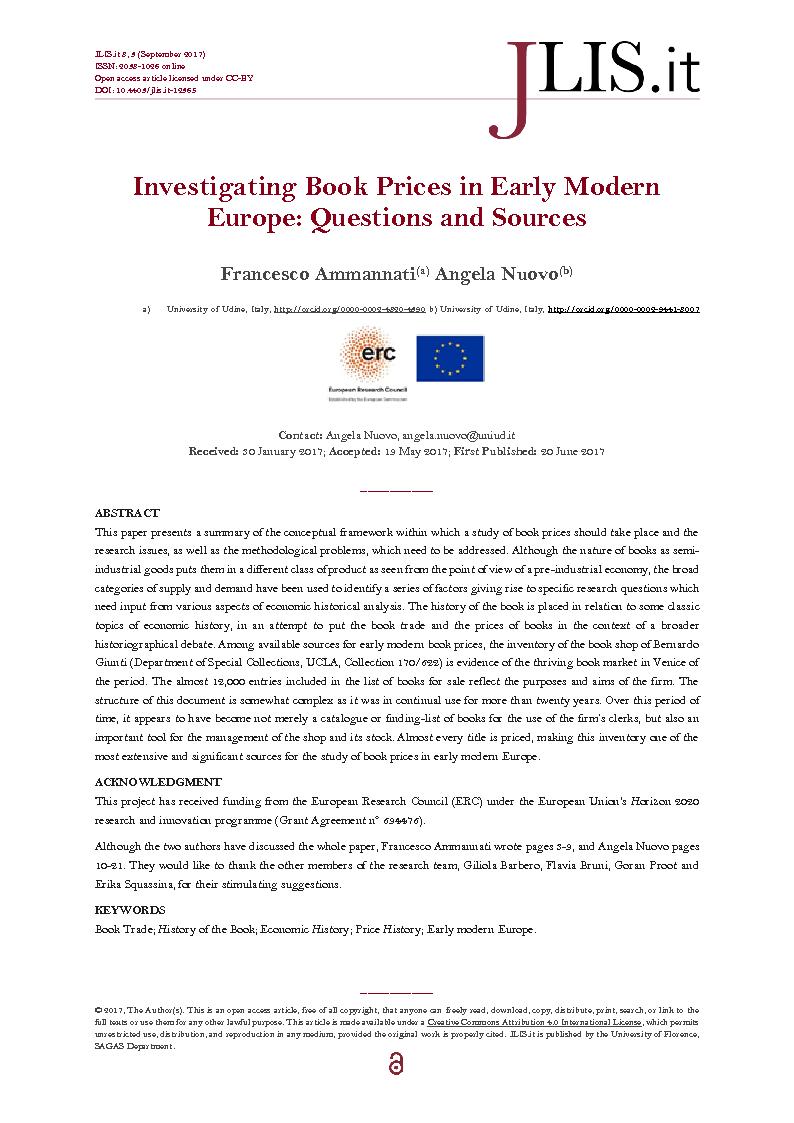Investigating Book Prices in Early Modern Europe : Questions and Sources
1-25 p.
Il contributo presenta in modo sintetico il quadro concettuale all'interno del quale uno studio dei prezzi dei libri nella prima età moderna dovrebbe muoversi, così come i problemi metodologici da affrontare. Nonostante la natura di manufatto semi-industriale ponga il libro a stampa in una classe merceologica del tutto particolare nell'economia pre-industriale, è possibile utilizzare le categorie generali di domanda e offerta per identificare alcuni fattori atti ad impostare specifici percorsi di ricerca basati sull'analisi storico-economica. La storia del libro può essere quindi messa in relazione con alcuni temi classici della storia economica, allo scopo di inserire il problema del commercio librario e dei prezzi dei libri in un dibattito storiografico più ampio. Tra le fonti disponibili per lo studio dei prezzi dei libri nella prima età moderna,.
l'inventario di bottega di Bernardo Giunti (Department of Special Collections, UCLA, Collection 170/622) è una chiara testimonianza del fiorente mercato librario allora esistente a Venezia. Le quasi 12.000 registrazioni incluse nella lista dei libri in vendita riflettono gli scopi e gli obiettivi dell'azienda. La struttura di questo documento è decisamente complessa, frutto di più di venti anni di uso continuo (1600-1620 c.). Lungo questo periodo di tempo, il documento sembra essere evoluto da un semplice elenco o catalogo ad uso del personale interno a un importante strumento per la gestione della bottega e del suo magazzino. Quasi ogni titolo presenta un prezzo, e ciò rende questo inventario una delle fonti più ampie e significative per lo studio dei prezzi dei libri nella prima età moderna.This project has received funding from the European Research Council (ERC) under the European Union's Horizon 2020 research and innovation programme (Grant Agreement n° 694476). [Testo dell'editore].
This paper presents a summary of the conceptual framework within which a study of book prices should take place and the research issues, as well as the methodological problems, which need to be addressed. Although the nature of books as semi-industrial goods puts them in a different class of product as seen from the point of view of a pre-industrial economy, the broad categories of supply and demand have been used to identify a series of factors giving rise to specific research questions which need input from various aspects of economic historical analysis. The history of the book is placed in relation to some classic topics of economic history, in an attempt to place the book trade and the prices of books in the context of a broader historiographical debate. Among available sources for early modern book prices, the inventory of the book shop of Bernardo Giunti (Department of Special Collections, UCLA, Collection 170/622) is evidence of the thriving book market in Venice of the period.
The almost 12,000 entries included in the list of books for sale reflect the purposes and aims of the firm. The structure of this document is somewhat complex as it was in continual use for more than twenty years. Over this period time, it appears to have become not merely a catalogue or finding-list of books for the use of the firm's clerks, but also an important tool for the management of the shop and its stock. Almost every title is priced, making this inventory one of the most extensive and significant sources for the study of book prices in early modern Europe. This project has received funding from the European Research Council (ERC) under the European Union's Horizon 2020 research and innovation programme (Grant Agreement n° 694476). [Publisher's Text].
-
Articles du même numéro (disponibles individuellement)
-
-
Informations
Code DOI : 10.4403/jlis.it-12365
ISSN: 2038-1026
KEYWORDS
- Book Trade, History of the Book, Economic History, Price History, Early modern Europe



